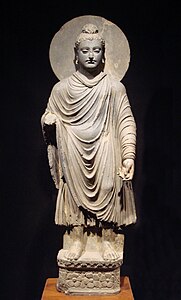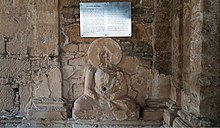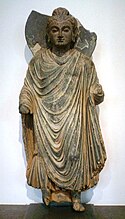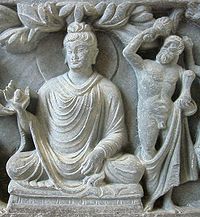Buddhism in Pakistan

Buddhism in Pakistan took root in the third century BCE under the Mauryan king Ashoka.[1][2][3] The Major Rock Edicts of Ashoka inscribed on rock boulders in Mansehra and Shahbaz Garhi written in the Kharosthi script recording aspects of the emperor's dharma or righteous law represent some of the earliest evidence of deciphered writing in South Asia, dating to middle of the third century BCE.[4] The Indo-Greek king Menander embraced Buddhism as attested in the Milinda Panha, which dates from sometime between 100 BC and 200 AD, following a dialogue with the monk Nāgasena in Sagala, present-day Sialkot.[5]
Mahayana Buddhism, one of the most prominent branches of Buddhism today, is believed to have been originated in the region of Gandhara, although its total number of confirmed Buddhists is a fraction of what it was.[6][7][8] In the Gandhara region, Greco-Buddhist art and sculptures flourished.[9]
Buddhism thrived until the 6th century, when the religion began to decline after the invasion by Alchon Huns,[10][11][12] until by the end of the 14th century, Buddhism had largely disappeared following the muslim conquests in the Indian subcontinent.[13][14][15]
In 2012, the National Database and Registration Authority (NADRA) of Pakistan indicated that the contemporary Buddhist population of Pakistan was minuscule, with 1,492 adult holders of national identity cards (CNICs). The total population of Buddhists is therefore unlikely to be more than a few thousand.[16] In 2017, the number of Buddhist voters was stated to be 1,884, and they were mostly concentrated in Sindh and Punjab.[17]
The only functional Buddhist temple in Pakistan is in the Diplomatic Enclave at Islamabad, used by Buddhist diplomats from countries like Sri Lanka.[18] Recently in 2023, Fo Guang Shan, a large international Buddhist organization has been invited by the Pakistani government to reconnect the local indigenous Buddhist population to the faith by organizing event, reciting prayers and singing hymns to praise the Buddha in the local tongue. [19]
History
Buddhism became prominent in merchant communities and then spread throughout the

In the 2nd century B.C.,

During the two centuries of their rule, the Indo-Greek kings combined the Greek and Indian languages and symbols, as seen on their coins, and blended Greek and Indian ideas, as seen in the archaeological remains.[28] The diffusion of Indo-Greek culture had consequences which are still felt today, particularly through the influence of Greco-Buddhist art.[29]
Following the foundation of the Kushan empire by the invading Yuezhi nomads in the 1st century BCE, the Kushans adopted elements of the Hellenistic culture of the Indo-Greeks.[30] During Kushan rule, Gandharan Buddhism was at the height of its influence and a significant number of Buddhist centers were built or renovated.[31]
The Buddhist art of
Between the 5th and 8th centuries, Chinese scholars traveling through the region, such as Faxian, Xuanzang, Yijing, Hui-sheng, and Sung-Yun, began to speak of a decline of the Buddhist Sangha in the northwestern parts of Indian subcontinent, especially in the wake of the Alchon Hun invasion from Central Asia in the 6th century CE.[11] Xuanzang wrote that numerous monasteries in north-western Indian subcontinent had been reduced to ruins by the Huns.[11][37]
The Alchons apparently undertook the mass destruction of Buddhist monasteries and
Mihirakula in particular is remembered by
According to Peter Harvey, the religion recovered slowly from these invasions during the 7th century, with the "Buddhism of Punjab and Sindh remaining strong".[43]
However, the religion further declined following the Muslim conquests in the Indian subcontinent.[44] As early as the 8th century, Arab conquerors conquered the southern part of present-day Pakistan. The Buddhist monk Xuanzang observed that Buddhism was already declining in the Sindh region when he visited in the 7th century.[45] While Buddhism declined and ultimately disappeared after Arab conquest mainly due to conversion of almost all of the Buddhist population of Sindh to Islam. Derryl Maclean attributes the decline of Buddhism in Sindh to the socio-economic differences between Hinduism and Buddhism in the region, with Buddhism being mainly urban and mercantile, while Hinduism was rural and non-mercantile.[13] The Arabs attracted and converted the Buddhist classes, but for the rural and non-mercantile parts, they promoted a more decentralized authority and appointed Brahmins for the task.[13]
In a second wave, from the 10th through the 12th centuries, the
Archaeological sites
Khyber Pakhtunkhwa

Famed for its unique
The monastic complex called Takht-i-Bahi is located in the Mardan district. It was unearthed in the early 20th century, and in 1980, it was included in the UNESCO World Heritage list as the largest Buddhist remains in Gandhara, along with the Seri Bahlol urban remains that date back to the same period, located about a kilometer south.[47]
Punjab

Most of the archaeological sites of Taxila are located around Taxila Museum. For over 1,000 years, Taxila remained famous as a center of learning Gandharan art of sculpture, architecture, education and Buddhism in the days of Buddhist glory.[53] There are over 50 archaeological sites scattered around Taxila. Some of the most important sites are the Dhamarajika Stupa and Monastery (300 BC – 200 AD), Bhir Mound (600–200 BC), Sirkap (200 BC – 600 AD), Jandial Temple (c.250 BC) and Jaulian Monastery (200 – 600 AD).[54]
A museum comprising various sections with rich archaeological finds of Taxila, arranged in chronological order and properly labeled, has been established close to the site.[54]
Sindh
Buddhist sites in Sindh are numerous but ill preserved in various stages of deterioration. Sites at
Balochistan

Chinese Buddhist traveller Hiuen Tsang reported many Buddhist temples in coastal regions of Makran, Balochistan. The remains of Buddhist cave city called Godrani caves can still be seen today.[56][57][58]
Abū Rayḥān Muḥammad ibn Aḥmad Al-Bīrūnī states in his book Alberuni's India that the coast of India begins with Tiz, the capital of Makran.[59]
According to historian Andre Wink:
Further evidence in the
caves of Gondrani, and as their constructions show these caves were undoubtedly Buddhist. Traveling through the Kij valley further west (then under the government of Persia) Hiuen Tsang saw some 100 Buddhist monasteries and 6000 priests. He also saw several hundred Deva temples in this part of Makran, and in the town of Su-nu li-chi-shi-fa-lo - which is probably Qasrqand - he saw a temple of Maheshvara Deva, richly adorned and sculptured. There is thus very wide extension of Indian cultural forms in Makran in the seventh century, even in the period when it fell under Persian sovereignty. By comparison in more recent times the last place of Hindu pilgrimage in Makran was Hinglaj, 256 km west of present-day Karachi in Las Bela.[60]
Wink has recorded Hiuen Tsang's notings on the language and script in use in easternmost Makran (eastern parts of Pakistani Balochistan and Sindh):
Hiuen Tsang considered the script which was in use in Makran to be 'much the same as India', but the spoken language 'differed a little from that of India.'[61]
Gilgit Baltistan

The region has a number of surviving Buddhist archaeological sites, including the
Demographics
The presence of Pakistani Buddhists in modern Pakistan is unclear,[63] although a few Pakistanis have reported themselves as Buddhist. A report mentions that they are only found in the Azad Kashmir region.[64] The Nurbakhshi sect is said to retain some elements of Buddhism.[65]
According to the National Database and Registration Authority (NADRA), there were 1,492 buddhists in holding national identity cards (CNICs) in 2012.[16] In 2017, it increased to 1,884 holders. They are mostly concentrated in Sindh and Punjab regions.[17] According to a report, most of the Baori Buddhists do not have CNIC cards, and the actual Buddhist population could exceed 16,000.[66]
In Punjab, Buddhists live primarily in the outskirts of the Mandi Yazman and Rahimyar Khan of Rohi region. Today, they have around 15 colonies in various villages of Mandi Yazman.[66]
Buddhism in modern Pakistan
Lala Rajoo Raam is the representative of the Baori Buddhists community. He is also a councillor for Chak number 75 DB, Union Council number 88. He also twice contested elections for the Punjab assembly.[66]
Taliban destruction of Buddhist relics

The
Pakistan Buddhist tourism

In March 2013, a group of around 20 Buddhist monks from South Korea made the journey to the monastery of Takht-i-Bahi, 170 kilometers (106 miles) from Islamabad. The monks defied appeals from Seoul to abandon their trip for safety reasons, and were guarded by Pakistani security forces on their visit to the monastery, built of ochre-colored stone and nestled on a mountainside. From around 1,000 years BCE until the 7th century CE, northern Pakistan and parts of modern Afghanistan formed the Gandhara kingdom, where Greek and Buddhist customs mixed to create what became the Mahayana strand of the religion. The monk Marananta set out from what is now northwest Pakistan to cross China and spread Buddhism in the Korean peninsula during the 4th century. The authorities are even planning package tours for visitors from China, Japan, Singapore and South Korea, including trips to the Buddhist sites at Takht-e-Bahi, Swat, Peshawar and Taxila, near Islamabad.[79]
Historical figures
Some Buddhist historical figures who hailed from present-day Pakistan include:
- Khema from Sialkot, 6th century B.C.E[80][81]
- Bhadda Kapilani from Sialkot, 6th century B.C.E[82][83][84]
- Anoja from Sialkot, 6th century B.C.E[85][86]
- Kumaralata from Taxila, 3rd century C.E[87][88][89]
- Asanga from Peshawar, 4th-century C.E.[90][91]
- Oddiyana(Swat), 7th century A.D
- Vasubandhu from Peshawar, 4th to 5th century CE[92][93]
- Padmasambhava from Swat, 8th century CE[94][95][96]
- Tridev Roy, Pakistani Buddhist politician and leader
Gallery
-
Shingardar stupa in Ghalegay
-
Thul Mir Rukan stupa in Sindh
-
Gumbatona stupa, Swat, KPK, a rare example true domed stupa 1st or 2nd century AD
See also
- History of Buddhism
- Gandharan Buddhism
- Hindu and Buddhist architectural heritage of Pakistan
- History of Pakistan
- Mansehra Rock Edicts
- Silk Road transmission of Buddhism
- Decline of Buddhism in the Indian subcontinent
- Index: Buddhism by country
References
- ISBN 978-0-8239-4001-1. Archivedfrom the original on 15 January 2023. Retrieved 4 August 2022.
- ^ "Buddhism In Pakistan". pakteahouse.net. Archived from the original on 20 January 2015. Retrieved 20 January 2015.
- ISBN 9780691157863. Archivedfrom the original on 15 January 2023. Retrieved 21 November 2021.
- ^ Department of Archaeology and Museums (30 January 2004). "UNESCO world heritage Centre - Mansehra Rock Edicts". Whc.unesco.org. Retrieved 30 March 2011.
- ^ ISBN 978-81-208-0893-5.
- ^ "Remembering Pakistan's Buddhist past | The Express Tribune". tribune.com.pk. 11 June 2022. Retrieved 16 January 2023.
- ^ Karashima, 2013.
- ^ Walser, Joseph, Nagarjuna in Context: Mahayana Buddhism and Early Indian Culture, Columbia University Press, 2005, p. 25.
- ^ "Long Read: A Pakistani homeland for Buddhism: Buddhist art, Muslim nationalism and global public history". South Asia@LSE. 22 July 2019. Retrieved 16 January 2023.
- ^ ISBN 0-8135-1304-9.
- ^ ISBN 978-0-87779-044-0.
- ^ ISBN 978-90-474-2006-4.
- ^ ISBN 978-90-040-8551-0.
- ^ ISBN 978-1-108-04720-3.
- ^ ISBN 978-81-7835-792-8.
Buddhism survived in Gilgit and Baltistan until 13-14th Century, perhaps slightly longer in the nearby Swat Valley.
- ^ a b "Over 35,000 Buddhists, Baha'is call Pakistan home". Tribune. Archived from the original on 2 November 2012.
- ^ a b "Pakistan elections: Non-Muslim voters up by 30%, Hindus biggest minority". 28 May 2018. Archived from the original on 18 September 2020. Retrieved 9 August 2018.
- ^ "Vesak Festival in Islamabad". mfa.gov.lk. Archived from the original on 13 November 2016. Retrieved 5 May 2018.
- ^ 人間福報. "復興巴基斯坦佛教 佛光僧侶宣法 | 覺世.宗教". 人間福報 (in Chinese). Retrieved 2 June 2023.
- ^ "Furthermore, Buddhism was prominent in communities of merchants, who found it well suited to their needs and who increasingly established commercial links throughout the Mauryan empire". Jerry Bentley, Old World Encounters: Cross-Cultural Contacts and Exchanges in Pre-Modern Times (New York: Oxford University Press, 1993), 46.
- ^ "During the sixth and fifth centuries B.C.E. (Before Common Era), commerce and cash became increasingly important in an economy previously dominated by self-sufficient production and bartered exchange. Merchants found Buddhist moral and ethical teachings an attractive alternative to the esoteric rituals of the traditional Brahmin priesthood, which seemed to cater exclusively to Brahmin interests while ignoring those of the new and emerging social classes." Jerry Bentley, Old World Encounters: Cross-Cultural Contacts and Exchanges in Pre-Modern Times (New York: Oxford University Press, 1993), 43.
- ^ "Merchants proved to be an efficient vector of the Buddhist faith, as they established diaspora communities in the string of oasis towns-Merv, Bukhara, Samarkand, Kashgar, Khotan, Kuqa, Turpan, Dunhuang – that served as lifeline of the silk roads through central Asia." Jerry Bentley, Old World Encounters: Cross-Cultural Contacts and Exchanges in Pre-Modern Times (New York: Oxford University Press, 1993), 47-48.
- ^ Hermann Kulke 2004, p. 67.
- from the original on 8 August 2021. Retrieved 9 August 2021.
- ^ Narain, "The Indo-Greeks" 2003, p. 124
- ^ Plutarch, Praec. reip. ger. 28, 6
- ^ Foreign Impact on Indian Life and Culture (c. 326 B.C. to C. 300 A.D.) Satyendra Nath Naskar, Abhinav Publications, 1996, p. 69 [11]
- ^ "A vast hoard of coins, with a mixture of Greek profiles and Indian symbols, along with interesting sculptures and some monumental remains from Taxila, Sirkap and Sirsukh, point to a rich fusion of Indian and Hellenistic influences", India, the Ancient Past, Burjor Avari, p. 130
- ^ Ghose, Sanujit (2011). "Cultural links between India and the Greco-Roman world" Archived 18 November 2022 at the Wayback Machine. Ancient History Encyclopedia
- ^ Xinru Liu, The Silk Road in World History (New York: Oxford University Press, 2010), 42.
- ^ Kurt A. Behrendt, The Buddhist architecture of Gandhara, Handbuch der Orientalistik Brill, 2004, p. 13
- ISBN 978-0-691-21747-5. Archivedfrom the original on 15 January 2023. Retrieved 12 December 2021.
- ^ Kurt Behrendt, Pia Brancaccio, Gandharan Buddhism: Archaeology, Art, and Texts, 2006 p. 10
- ^ "UW Press: Ancient Buddhist Scrolls from Gandhara" Archived 2013-09-27 at the Wayback Machine. Retrieved 2008-09-04.
- ^ Richard Salomon. Ancient Buddhist Scrolls from Gandhāra: The British Library Kharosthī Fragments, with contributions by Raymond Allchin and Mark Barnard. Seattle: University of Washington Press; London: The British Library, 1999. p. 181
- ^ a b Heirman, Ann; Bumbacher, Stephan Peter (editors). The Spread of Buddhism, Brill, p. 57
- ^ "Historical Development of Buddhism in India – Buddhism under the Guptas and Palas". Encyclopædia Britannica. Retrieved 12 September 2015.
- ^ a b Ghosh, Amalananda (1965). Taxila. CUP Archive. p. 791.
- ISBN 9780674981287.
- ISBN 9780984404308. Retrieved 24 March 2017.
- ISBN 9789004135956.
- ISBN 9780674981287.
- ^ Harvey 2013, p. 194.
- ^ Levy, Robert I. Mesocosm: Hinduism and the Organization of a Traditional Newar City in Nepal. Berkeley: University of California Press, c1990 1990.
- ^ Shu Hikosaka, G. John Samuel, Can̲ārttanam Pārttacārati (ed.), Buddhist themes in modern Indian literature, Inst. of Asian Studies, 1992, p. 268
- ISBN 978-0-19-994823-9.
- ^ "Takht Bhai". www.findpk.com. Archived from the original on 10 August 2015.
- ISBN 978-81-208-0281-0. Archivedfrom the original on 15 January 2023. Retrieved 4 August 2022.
- ^ ‘Uḍḍiyāna and Kashmir’, pp 265-269 ‘The Śaiva Exegesis of Kashmir’, in Mélanges tantriques à la mémoire d’Hélène Brunner. Tantric Studies in Memory of Hélène Brunner, Collection Indologie 106, EFEO, Institut français de Pondichéry (IFP), ed. Dominic Goodall and André Padoux, 2007.)
- ISBN 978-0-231-16241-8. Archivedfrom the original on 15 January 2023. Retrieved 4 August 2022.
- ^ Shah, Bipin. "Ancient Uddayana-the land of Buddha at Rajgriha, prior to establishment of Patliputra in Ganges Doab". Research gate. Retrieved 3 February 2021.
- ISBN 9780198605607. Archivedfrom the original on 16 July 2017. Retrieved 11 February 2016.
- ^ "Taxila". www.pakistantoursguide.com/. Archived from the original on 21 January 2015.
- ^ a b "Buddhism in Taxila". www.findpk.com/Pakistan/html/buddhist_sites.html. Archived from the original on 10 August 2015.
- ^ "Ancient Buddhist terracottas from Mirpurkhas in Pakistan". Art of South Asia, the Silk Road and Beyond. 18 October 2016. Archived from the original on 18 September 2020. Retrieved 8 August 2018.
- ^ Royal Geographical Society (Great Britain) (1896). John Scott Keltie (ed.). The Geographical Journal Volume 7. Great Britain: Royal Geographical Society. p. 399.
- ISBN 978-0391041257. Retrieved 19 March 2013.
- ^ Taylor & Francis (1989). South Asian Studies: Journal of the Society for South Asian Studies. University of Michigan: The Society for South Asian Studies.
- Kegan Paul, Trench, Trübner & Co. p. 208. Archivedfrom the original on 28 May 2022. Retrieved 11 August 2022.
- ^ Al-Hind: Early medieval India and the expansion of Islam, 7th–11th centuries by André Wink page 135
- ^ Al-Hind: Early medieval India and the expansion of Islam, 7th–11th centuries By André Wink Page 137
- ^ "Episode 1: A Window to Gilgit-Baltistan".
- ^ "Thread, Not Scissor Common Spiritual Heritage For Peace And Harmony, Ahmad Salim, SARRC – December 2008" (PDF). Archived from the original (PDF) on 16 October 2018. Retrieved 15 October 2018.
- ^ 800 years of Buddhism in Pakistan, Emi Foulk, The Friday Times, July 18, 2008
- ^ "THE NURBAKHSHI RELIGION IN BALTISTAN, Xabier Rentería, 26-11/2007". Archived from the original on 3 June 2019. Retrieved 15 October 2018.
- ^ a b c "Meeting Pakistan's Buddhists". 8 September 2017. Archived from the original on 12 November 2020. Retrieved 3 June 2019.
- ^ "Monks to start peace march tomorrow,August 05, 2002". Archived from the original on 16 October 2018. Retrieved 15 October 2018.
- ^ Hays, Jeffrey. "EARLY HISTORY OF BUDDHISM – Facts and Details". factsanddetails.com. Archived from the original on 19 October 2017. Retrieved 5 May 2018.
- ISBN 978-0-316-32241-6.
The Taliban destroyed the Buddhist statues and stupas where we played Kushan kings haram Jehanabad Buddha.
- ^ Wijewardena, W.A. (17 February 2014). "'I am Malala': But then, we all are Malalas, aren't we?". Daily FT. Archived from the original on 24 September 2015.
- ^ Wijewardena, W.A (17 February 2014). "'I am Malala': But Then, We All Are Malalas, Aren't We?". Colombo Telegraph. Archived from the original on 25 September 2015.
- ^ "Attack on giant Pakistan Buddha". BBC NEWS. 12 September 2007. Archived from the original on 19 April 2016.
- ^ "Another attack on the giant Buddha of Swat". AsiaNews.it. 10 November 2007. Archived from the original on 25 September 2015.
- ^ "Taliban and traffickers destroying Pakistan's Buddhist heritage". AsiaNews.it. 22 October 2012. Archived from the original on 12 May 2016.
- ^ "Taliban trying to destroy Buddhist art from the Gandhara period". AsiaNews.it. 27 November 2009. Archived from the original on 23 September 2015.
- ^ Felix, Qaiser (21 April 2009). "Archbishop of Lahore: Sharia in the Swat Valley is contrary to Pakistan's founding principles". AsiaNews.it. Archived from the original on 23 September 2015.
- ^ Rizvi, Jaffer (6 July 2012). "Pakistan police foil huge artefact smuggling attempt". BBC News. Archived from the original on 24 September 2015.
- ^ Khaliq, Fazal (7 November 2016). "Iconic Buddha in Swat valley restored after nine years when Taliban defaced it". DAWN. Archived from the original on 7 January 2017.
- ^ "Pakistan hopes for Buddhist tourism boost". Dawn News. Archived from the original on 20 January 2015.
- ISBN 978-81-7017-317-5. Archivedfrom the original on 15 January 2023. Retrieved 4 August 2022.
- ISBN 978-0-691-15786-3. Archivedfrom the original on 15 January 2023. Retrieved 4 August 2022.
- ISBN 978-81-7386-112-3. Archivedfrom the original on 15 January 2023. Retrieved 4 August 2022.
- ISBN 978-81-7017-226-0. Archivedfrom the original on 15 January 2023. Retrieved 4 August 2022.
- ISBN 978-81-88934-39-3. Archivedfrom the original on 15 January 2023. Retrieved 4 August 2022.
- ISBN 978-81-208-3022-6. Archivedfrom the original on 15 January 2023. Retrieved 4 August 2022.
- ISBN 978-0-691-15786-3. Archivedfrom the original on 15 January 2023. Retrieved 4 August 2022.
- ISBN 978-81-208-0372-5. Archivedfrom the original on 15 January 2023. Retrieved 4 August 2022.
The venerable Kumāralāta (labdha) was a native of Takṣaśilā.
- ISBN 978-81-208-0265-0. Archivedfrom the original on 15 January 2023. Retrieved 4 August 2022.
Kumāralāta was the founder of the Sautrántika school, and came from Taxila.
- ISBN 978-81-8424-568-4. Archivedfrom the original on 15 January 2023. Retrieved 4 August 2022.
- ISBN 978-0-691-15786-3.
Born into a brāhmana family in Puruṣapura (modern-day Peshawar, Pakistan), Asanga originally studied under Sarvāstivāda (possibly Māhiṣasaka) teachers but converted to the Mahāyāna later in life.
- ISBN 978-1-57607-355-1.
Asanga, born in the Gandara region of present-day Pakistan in the city of Purusapura (the modern Peshawar) as the third son of Prasannasila (or Prakasila), was probably active around the fourth or fifth century.
- ISBN 978-81-208-1967-2.
According to tradition Vasubandhu was born in Puruşapura, the capital of Gāndhāra (the modern Peshawar in Western Pakistan).
- ISBN 978-0-7914-9882-8.
The principal founders of this school, the brothers Asanga and Vasubandhu, were born in Puruṣapura, today Peshawar in Pakistan, and lived probably in the fourth century.
- ISBN 978-90-74597-44-9. Archivedfrom the original on 15 January 2023. Retrieved 4 August 2022.
- ISBN 978-1-64805-981-0. Archivedfrom the original on 15 January 2023. Retrieved 4 August 2022.
- ISBN 978-0-300-17217-1.
Works cited
- Harvey, Peter (2013). An Introduction to Buddhism: Teachings, History and Practices. Cambridge University Press. ISBN 978-0-521-85942-4.
- Hermann Kulke; Dietmar Rothermund (2004). A History of India (4th ed.). ISBN 0-415-15481-2.







